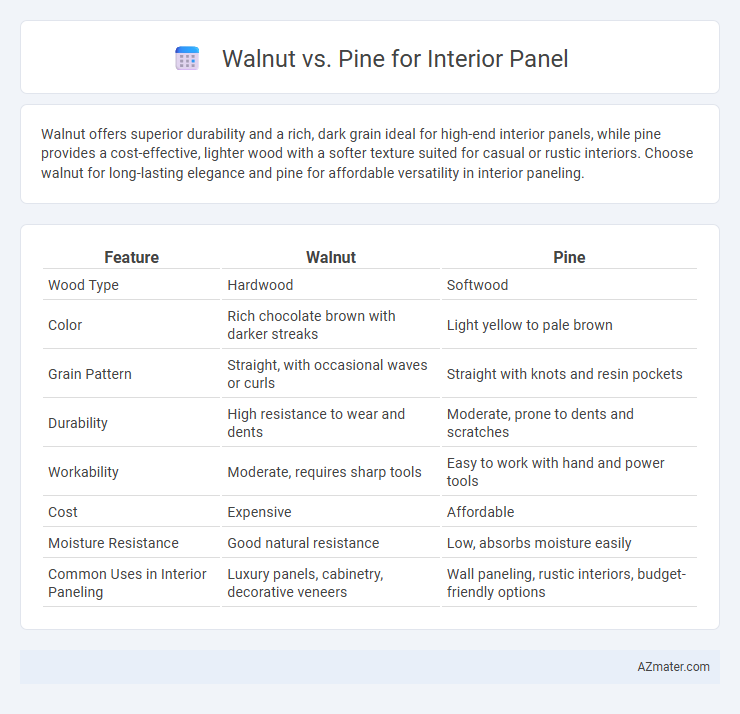Walnut offers superior durability and a rich, dark grain ideal for high-end interior panels, while pine provides a cost-effective, lighter wood with a softer texture suited for casual or rustic interiors. Choose walnut for long-lasting elegance and pine for affordable versatility in interior paneling.
Table of Comparison
| Feature | Walnut | Pine |
|---|---|---|
| Wood Type | Hardwood | Softwood |
| Color | Rich chocolate brown with darker streaks | Light yellow to pale brown |
| Grain Pattern | Straight, with occasional waves or curls | Straight with knots and resin pockets |
| Durability | High resistance to wear and dents | Moderate, prone to dents and scratches |
| Workability | Moderate, requires sharp tools | Easy to work with hand and power tools |
| Cost | Expensive | Affordable |
| Moisture Resistance | Good natural resistance | Low, absorbs moisture easily |
| Common Uses in Interior Paneling | Luxury panels, cabinetry, decorative veneers | Wall paneling, rustic interiors, budget-friendly options |
Overview: Walnut vs Pine for Interior Paneling
Walnut offers rich, dark tones and a dense grain structure that provides durability and a luxurious aesthetic for interior paneling. Pine features a lighter color palette with a softer texture, making it easier to work with and ideal for budget-friendly, casual interiors. Choosing between walnut and pine depends on desired durability, visual warmth, and price point for interior panel applications.
Wood Characteristics: Walnut vs Pine
Walnut wood features a rich, dark brown color with a fine, straight grain, offering a luxurious and durable surface ideal for high-end interior panels. Pine, characterized by its lighter yellowish tone and prominent knots, provides a softer, more rustic appearance that is easier to work with but less resistant to dents and scratches. Walnut's density and natural oils contribute to superior longevity and stability, whereas pine's faster growth rate makes it a more affordable and sustainable option for interior applications.
Aesthetic Appeal and Visual Differences
Walnut boasts rich, dark brown tones with deep grain patterns that create a luxurious and sophisticated atmosphere in interior panels, making it ideal for high-end designs. Pine features lighter hues with subtle knots and a more uniform texture, offering a rustic and casual aesthetic that brightens spaces. The contrast in walnut's complexity and pine's simplicity provides distinct visual choices for interior styling.
Durability and Hardness Comparison
Walnut boasts a Janka hardness rating of 1,010, offering superior durability and resistance to dents compared to Pine, which has a softer Janka rating of 380. This makes Walnut a preferred choice for interior paneling in high-traffic areas where impact resistance is critical. Pine's softness allows for easier machining and a rustic aesthetic but results in increased susceptibility to scratches and dents over time.
Cost Analysis: Walnut vs Pine Panels
Walnut panels generally cost significantly more than pine panels due to walnut's rich, dense grain and durability, making it a premium choice for interior design. Pine panels are more budget-friendly and widely available, appealing to projects with tighter cost constraints or those seeking a rustic aesthetic. When weighing initial expenses against long-term value, walnut offers superior longevity and visual appeal, while pine provides cost efficiency and ease of installation.
Ease of Installation and Workability
Walnut offers a denser, harder surface than pine, making it slightly more challenging to cut and shape but providing superior durability for interior panels. Pine, being a softer wood, is easier to work with using standard tools and allows for quicker installation due to its lighter weight and less resistance to nails and screws. The choice between walnut and pine for ease of installation and workability depends on balancing walnut's strength and longevity against pine's user-friendly handling and faster project completion.
Maintenance Requirements of Walnut and Pine
Walnut interior panels require minimal maintenance due to their natural resistance to wear and moisture, but periodic dusting and occasional polishing with a quality wood conditioner help preserve their rich color and luster. Pine panels need more frequent upkeep, including regular cleaning to prevent dirt buildup and the application of protective finishes to guard against dents and scratches because of their softer wood grain. Both woods benefit from controlled indoor humidity to avoid warping, but walnut's dense structure generally offers better long-term durability with less effort.
Environmental Impact and Sustainability
Walnut panels are sourced from hardwood trees that grow slower, making their environmental footprint higher due to longer regeneration periods, whereas pine panels come from fast-growing softwood trees, promoting more sustainable forestry practices. Pine's renewable nature and carbon sequestration properties contribute to lower emissions and greater environmental benefits compared to walnut. Both woods are biodegradable, but responsibly managed pine forests provide a more eco-friendly option for interior paneling with reduced habitat disruption and resource depletion.
Popular Uses in Interior Design
Walnut wood is prized in interior design for its rich, dark hues and fine grain, making it a popular choice for high-end paneling, cabinetry, and furniture that require a luxurious and warm ambiance. Pine, characterized by its lighter color and softer texture, is commonly used for rustic or country-style interiors, often serving as wall paneling, ceiling beams, and trim due to its affordability and ease of staining or painting. Both woods offer distinct aesthetics and functional benefits, with walnut favored for elegance and durability, while pine supports a more casual, versatile design approach.
Choosing the Right Wood: Walnut or Pine
Walnut offers rich, dark tones and a tight grain pattern, making it ideal for elegant, high-end interior panels that emphasize durability and luxurious aesthetics. Pine, known for its light color and prominent knots, provides a more rustic, cost-effective option with ease of customization and faster installation. Selecting between walnut and pine depends on your budget, desired look, and the room's usage, with walnut excelling in sophistication and pine in versatility.

Infographic: Walnut vs Pine for Interior Panel
 azmater.com
azmater.com